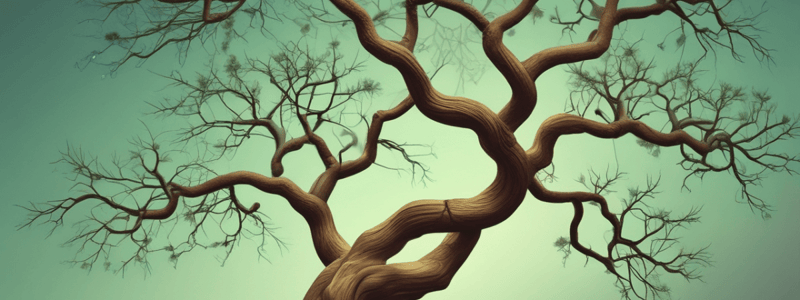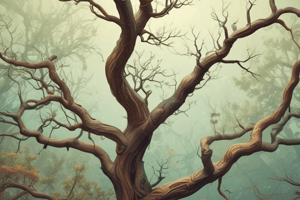Podcast
Questions and Answers
Which branch of biology focuses on the study of microorganisms like bacteria and viruses?
Which branch of biology focuses on the study of microorganisms like bacteria and viruses?
- Botany
- Microbiology (correct)
- Ecology
- Zoology
Which of these is NOT a level of organization in the biological hierarchy?
Which of these is NOT a level of organization in the biological hierarchy?
- Biomolecules (correct)
- Ecosystems
- Organelles
- Communities
What is the main function of carbohydrates in living organisms?
What is the main function of carbohydrates in living organisms?
- Catalysing chemical reactions
- Transporting substances across cell membranes
- Providing energy and structure (correct)
- Storing genetic information
Which of these is NOT a type of biological molecule?
Which of these is NOT a type of biological molecule?
What is the process by which cells convert light energy into chemical energy?
What is the process by which cells convert light energy into chemical energy?
Which cell process results in two daughter cells with the same number of chromosomes as the parent cell?
Which cell process results in two daughter cells with the same number of chromosomes as the parent cell?
What is the ability of an organism to maintain a stable internal environment called?
What is the ability of an organism to maintain a stable internal environment called?
Which of these is NOT a characteristic of living organisms?
Which of these is NOT a characteristic of living organisms?
Flashcards are hidden until you start studying
Study Notes
Branches of Biology
- Botany: study of plants and their interactions with the environment
- Zoology: study of animals and their interactions with the environment
- Microbiology: study of microorganisms, such as bacteria and viruses
- Ecology: study of the relationships between organisms and their environment
- Genetics: study of heredity, genes, and genetic variation
- Biochemistry: study of the chemical processes that occur within living organisms
- Molecular Biology: study of the structure, function, and interactions of biological molecules
- Cell Biology: study of the structure, function, and behavior of cells
- Evolutionary Biology: study of the processes that have shaped the diversity of life on Earth
Levels of Organization
- Molecules: building blocks of life, such as DNA, proteins, and carbohydrates
- Organelles: specialized structures within cells, such as mitochondria and ribosomes
- Cells: basic units of life, which can be prokaryotic or eukaryotic
- Tissues: groups of similar cells that perform a specific function
- Organs: structures composed of two or more types of tissue that work together
- Organ Systems: groups of organs that work together to perform a specific function
- Organisms: individual living things, such as animals, plants, and microorganisms
- Populations: groups of organisms of the same species that live in a specific area
- Ecosystems: communities of organisms and their physical environment
- Biosphere: all life on Earth, including all ecosystems and organisms
Biological Molecules
- Carbohydrates: provide energy and structure for organisms
- Proteins: perform a wide range of functions, including structure, transport, and catalysis
- Lipids: provide energy and structure for organisms, and also play a role in cell signaling
- Nucleic Acids: include DNA and RNA, which contain genetic information
- ATP: energy currency of the cell, used to power cellular processes
Cell Processes
- Photosynthesis: process by which plants and some other organisms convert light energy into chemical energy
- Cellular Respiration: process by which cells generate energy from glucose
- Mitosis: process of cell division that results in two daughter cells with the same number of chromosomes as the parent cell
- Meiosis: process of cell division that results in four daughter cells with half the number of chromosomes as the parent cell
- Homeostasis: ability of an organism to maintain a stable internal environment despite changes in the external environment
Branches of Biology
- Botany studies the life processes and environmental interactions of plants.
- Zoology focuses on animal species and their ecological relationships.
- Microbiology explores microorganisms, including bacteria and viruses, and their roles in ecosystems.
- Ecology examines the interplay between organisms and their habitats.
- Genetics analyzes heredity, the structure of genes, and variations among organisms.
- Biochemistry investigates the chemical processes vital for life's functions.
- Molecular Biology studies biological molecules pivotal for cellular functions and interactions.
- Cell Biology concerns the anatomy, functions, and behavior of cells, which are the fundamental units of life.
- Evolutionary Biology studies the mechanisms of evolution that drive the diversity of life on Earth.
Levels of Organization
- Molecules are the fundamental substances of life, including DNA, proteins, and carbohydrates that form structures and pathways.
- Organelles are specialized cell components, such as mitochondria (energy producers) and ribosomes (protein synthesizers).
- Cells are the simplest units of life, classified as prokaryotic (without a nucleus) or eukaryotic (with a nucleus).
- Tissues consist of similar cells grouped together to perform specific functions, like muscle or connective tissue.
- Organs are complex structures made up of various tissue types that cooperate for particular functions, such as the heart or lungs.
- Organ Systems are systems of organs that collaborate for broader physiological processes, like the digestive or circulatory system.
- Organisms represent individual living entities, ranging from simple bacteria to complex mammals.
- Populations consist of individuals of the same species cohabiting in a defined geographical area.
- Ecosystems include communities of diverse organisms interacting with each other and their physical environment.
- Biosphere encompasses all ecosystems and life forms on Earth, representing the global ecological system.
Biological Molecules
- Carbohydrates serve as primary energy sources for organisms and contribute to structural components like cellulose in plants.
- Proteins have diverse roles, functioning in structure, transporting substances, and catalyzing biochemical reactions as enzymes.
- Lipids provide energy storage, contribute to cellular structures (like membranes), and are involved in signaling processes.
- Nucleic Acids include DNA, which carries genetic blueprints, and RNA, crucial for protein synthesis.
- ATP (Adenosine Triphosphate) is the main energy currency of cells, fueling various cellular activities and metabolic processes.
Cell Processes
- Photosynthesis allows plants and some microorganisms to convert sunlight into chemical energy, producing glucose and oxygen.
- Cellular Respiration is the process that converts glucose into ATP, releasing energy required for cellular functions.
- Mitosis is a type of cell division that creates two identical daughter cells, maintaining the same chromosome number as the parent cell.
- Meiosis involves a specialized cell division that produces four genetically diverse daughter cells, each with half the original chromosome count, important for sexual reproduction.
- Homeostasis is the self-regulating process whereby organisms maintain a stable internal environment despite external fluctuations.
Studying That Suits You
Use AI to generate personalized quizzes and flashcards to suit your learning preferences.




